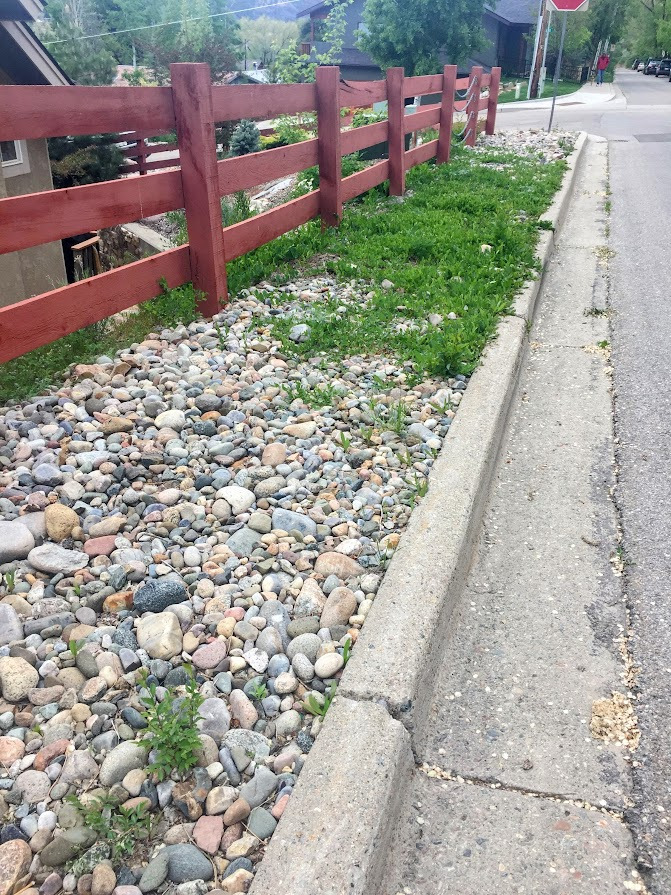11 Sep Myth Busting: Dry Streambeds, Cobble as Weed Control, Rototilling
MYTH #1 DRY STREAMBEDS BELONG IN A WATERWISE LANDSCAPE
FACT: DRY STREAMBEDS ARE NOT WATERWISE
Dry streambeds are not considered waterwise because they do not actively conserve or utilize water resources. A dry stream bed typically lacks vegetation or water-holding features, which means it does not efficiently capture or retain rainfall. And most commonly, dry streambeds are intended to direct rainwater off the property to the nearest impermeable surface like roads and sewer grates.
In waterwise landscaping, the focus is on maximizing water conservation and minimizing water waste. By contrast, dry stream beds are designed to mimic the appearance of natural water flow but do not contribute to water conservation efforts.
Rain gardens, on the other hand, add dimension and functional topography that increases aesthetic value, while maximizing use of water in the landscape.

MYTH #2 COBBLE ON TOP OF WEEDMAT = NO WEEDS
FACT: COBBLE AND WEEDMAT ARE A LOSING PROPOSITION FOR WEED CONTROL
Cobble and weedmat are ineffective in preventing weeds for a few reasons. The all-too-commonly used baseball sized round cobble especially is a landscape nightmare. Unlike a smaller (1.5 inch or smaller) angular gravel, cobble is too large to be able to knit together; instead, it creates pockets everywhere trapping debris that blows in, and resulting in nice organic soil overtime that the seeds that also blow in happily take root in.
Secondly, weedmat, also known as landscape fabric, may initially suppress weed growth by blocking sunlight. However, over time, organic matter accumulates on top of the fabric, allowing weed seeds to germinate and roots to penetrate through the mat. This can result in weeds growing on top of and through the weedmat, making it difficult to remove them.
Additionally, weedmat can hinder the natural soil processes, such as water infiltration and nutrient cycling, leading to poor plant health and drainage issues. It can also be challenging to maintain and repair if it gets damaged or needs adjustments.
To effectively prevent weeds, a combination of techniques is often recommended, including proper soil preparation, mulching, regular maintenance, and manual weed removal.
MYTH #3: ROTOTILLING IS GOOD FOR THE SOIL AND PREVENTS WEEDS
FACT: ROTOTILLING DISRUPTS SOIL HEALTH AND PROMOTES WEED GROWTH
Rototilling is often discouraged for soil health and weed control for several reasons. While it can initially break up compacted soil and incorporate organic matter, there are drawbacks to consider:
Soil Structure Disruption: Rototilling disrupts the natural structure of the soil by breaking up aggregates and destroying beneficial soil organisms. This can result in compaction and reduced soil aeration over time.
Erosion and Nutrient Loss: Tilling can expose bare soil, making it prone to erosion by wind or water. Additionally, tilling can accelerate the decomposition of organic matter, leading to the loss of valuable nutrients from the soil.
Weed Seed Distribution: Tilling can inadvertently bury weed seeds deeper into the soil, where they can remain dormant until conditions are favorable for germination. This can lead to increased weed populations over time.
Soil Moisture Loss: Tilling can disrupt the soil’s natural moisture-holding capacity and increase evaporation, potentially leading to dry soil conditions.
Instead of relying on rototilling, alternative practices like no-till or reduced-till methods can be beneficial for soil health and weed control. These methods focus on minimizing soil disturbance, promoting organic matter accumulation, and utilizing cover crops or mulch to suppress weed growth. It’s important to consider specific soil and environmental conditions when deciding on the most appropriate approach for your garden or farming practices.

Sorry, the comment form is closed at this time.